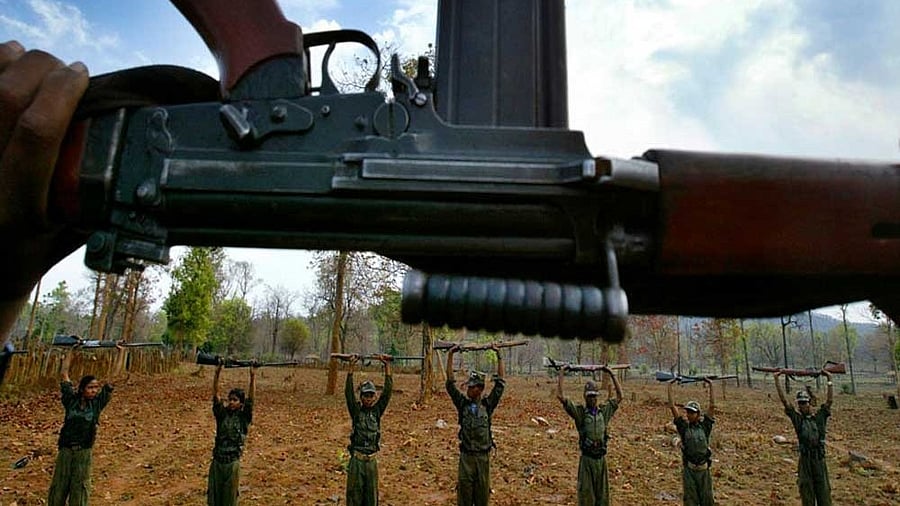
Representative image of Maoists.
Credits: PTI Photo
The death of Vikram Gowda (44), a much-wanted Maoist carrying a combined reward of Rs 5.5 lakh, in an encounter with Karnataka’s Anti-Naxal Force (ANF) in Kabbinale near Hebri in Udupi on November 18 has dealt a major blow to the Maoist movement in the state, where only seven others remain to be arrested. Continuous operations by the Thunderbolt commandos of the Kerala police since 2016 forced the Maoists to shift base from Wayanad to neighbouring Karnataka, where the ANF has been on their trail. Vikram led the Kabini Dalam in Karnataka.
However, this success should not induce complacency among the ANF personnel, as any laxity could lead to serious mishaps.
Two personnel of the Indo-Tibetan Border Police (ITBP) — Amar Panwar and K Rajesh — were killed in a landmine blast near Kodliyar village of Narayanpur district in Chhattisgarh on October 19. Personnel from the Border Security Force (BSF), ITBP, Bastar Fighters, District Reserve Guards (DRG) and the local police set out for Dhurbeda from their camps in different locations. While returning to their camps, the ITBP and civil police personnel encountered a landmine blast. Two DRG personnel also suffered injuries in the blast. Having suffered heavy losses in recent months, the Maoists were expected to strike as an act of retribution.
The Maoists are targeting both security forces and politicians to mark their presence. On October 19, Tirupati Bhandari, a Congress worker, was hacked to death in Usoor village of Bijapur district on suspicion of being a police informer. Nine BJP workers were killed between 2023 and March 2024. Maoists have killed 53 villagers in Bastar division till October this year, suspecting them to be police informers.
In one of the major success stories in recent times, security forces killed 38 Maoists carrying a collective reward of Rs 2.62 crore in an encounter near the Narayanpur-Dantewada borders on October 4. While the Chhattisgarh police claimed to have recovered 31 bodies, the Maoists admitted to losing 38 comrades in the fierce encounter. This marks a major setback for the Maoists, who have never suffered such heavy losses in their 24-year history in the region.
Large-scale surrenders by cadres in recent months have further demoralised the Maoists. With most of the top leadership either eliminated in encounters or dead due
to health reasons, the vacuum has adversely impacted the movement.
Over 200 Maoists have been killed in various operations launched by security forces this year, with 706 arrested and 735 surrendering. Abhujmand has been their stronghold since the 80s, covering a wide forested area of about 4,000 sq km, providing a safe haven for leaders to harbour and train their cadres. The villages in the region provided manpower for recruitment. The Maoists’ influence was strong in the villages, with no one daring to resist their hegemony. Kangaroo courts run by them decided the fate of villagers. Security forces have succeeded in penetrating half the area of Abhujmand and setting up Forward Operating Bases (FOB), displacing the Maoists and restricting their movement with sealed borders to prevent crossing into other states.
With their strength considerably depleted, the Maoists may not launch major attacks but could still resort to minor skirmishes to cause casualties among security forces while avoiding face-to-face confrontations. They are likely to increasingly use Improvised Explosive Devices (IEDs), necessitating high alertness and utmost precautions by security forces. Their expertise in the use of IEDs is undoubtedly high, having been trained by Sri Lanka’s Liberation Tigers of Tamil Eelam in the past.
Though Standard Operating Procedures dictate that forces should not return by the same routes they used to reach their operation sites, Maoists are aware of this tactic. They often ambush or place IEDs on likely return routes. Exhausted security personnel become easy prey on their return journey, often in a hurry to get back to their camps and prone to throwing caution to the wind. It is better to take all precautions, even if it takes longer to reach the camp.
While encouraging Maoists to surrender by offering incentives is important, ensuring the security of those who do surrender is crucial. Any casualty of surrendered extremists could deter others from surrendering. The Chhattisgarh government is revising its surrender policy by incorporating best practices from other states, such as offering jobs and houses, to make it more attractive and acceptable to hesitant Maoists.
The Karnataka government also came out with a revised surrender policy in May this year. Every effort should be made to attract the remaining few Maoists in Karnataka with this policy and put an end to the menace in the state.
(The writer is retired Inspector General of Police, CRPF)